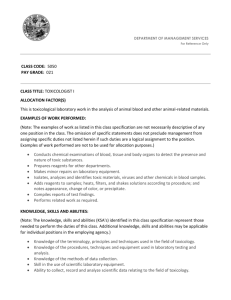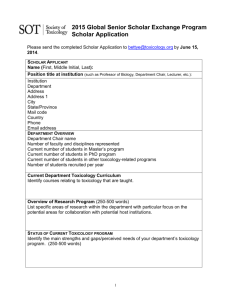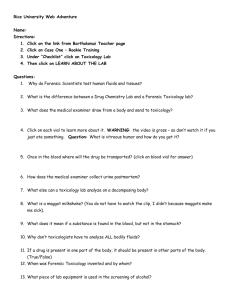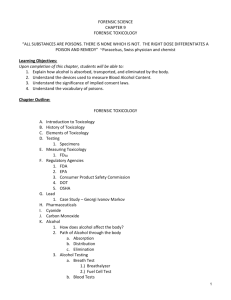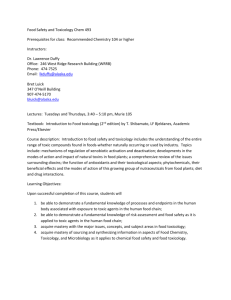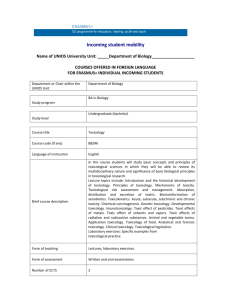Learning Objectives
advertisement
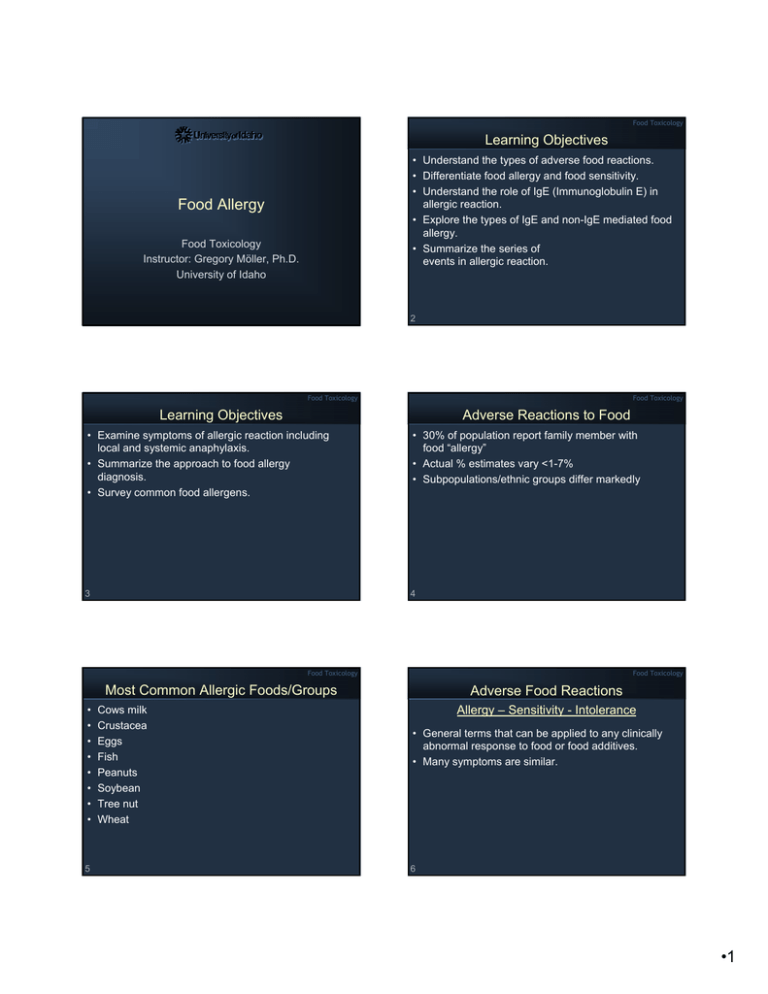
Food Toxicology Learning Objectives • Understand the types of adverse food reactions. • Differentiate food allergy and food sensitivity. • Understand the role of IgE (Immunoglobulin E) in allergic reaction. • Explore the types of IgE and non-IgE mediated food allergy. • Summarize the series of events in allergic reaction. Food Allergy Food Toxicology Instructor: Gregory Möller, Ph.D. University of Idaho 2 Food Toxicology Food Toxicology Learning Objectives Adverse Reactions to Food • Examine symptoms of allergic reaction including local and systemic anaphylaxis. • Summarize the approach to food allergy diagnosis. • Survey common food allergens. • 30% of population report family member with food “allergy” • Actual % estimates vary <1-7% • Subpopulations/ethnic groups differ markedly 3 4 Food Toxicology Food Toxicology Most Common Allergic Foods/Groups • • • • • • • • 5 Cows milk Crustacea Eggs Fish Peanuts Soybean Tree nut Wheat Adverse Food Reactions Allergy – Sensitivity - Intolerance • General terms that can be applied to any clinically abnormal response to food or food additives. • Many symptoms are similar. 6 •1 Food Toxicology Food Toxicology Types of Adverse Food Reactions • Allergy • Pharmacological (drug interaction) • Non-immune • Toxicity anaphylaxis (anaphylactoid) • Intolerance • Metabolic • Idiosyncrasy Types of Food Sensitivities and Allergies • True food allergy • Food sensitivities – Anaphylactoid reactions – Metabolic food disorders – Idiosyncratic reactions • Some in several classes • Food aversions – Mimic sensitivity but no blinded response 7 8 Food Toxicology Food Toxicology Food Allergy: Hypersensitivity Food Allergies: History • Immune-mediated reaction • Can be triggered by very small amounts of food • Occurs on second exposure or to a cross reacting antigen • Anaphylaxis and cutaneous reactions most common • Observed since early Greeks and Romans 9 10 – Hippocrates documents milk sensitivity • Injected normal person with fish extract - no effect (1921) – Injected serum of sensitive person, then fish extract allergic reaction • Researchers discovered IgE (Immunoglobulin E, antibody subclass) in serum was cause (1966) Food Toxicology Food Toxicology Food Allergy Epidemiology • Affect ~ 6% of children < 3 years old – Milk & soy • Cow’s milk: 2.5% – Over 80% tolerant by 5th birthday • Egg allergy: 1.5% Epidemiology • Small subpopulation at risk <1% • 65% of susceptible people have close relative with allergy • Increased intestinal permeability to macromolecules predisposes – Viral gastroenteritis, premature birth, cystic fibrosis – Leaky gut syndrome (LGS) – Over 85% tolerant by 3rd birthday • Peanut allergy: 0.5% – Clinical tolerance reached in a minority – Prevalence may be increasing in children 11 Freiler 12 •2 Food Toxicology Food Toxicology Epidemiology Pathophysiology • Higher in children with other atopic disorders – 35% of children with moderate to severe atopic dermatitis (eczema) – 6% of asthmatic children – Gut-Associated Lymphoid Tissue • Adverse reactions to food additives 0.5-1% of children 13 • GI tract forms a barrier to outside environment • GALT inhibits responses to non-dangerous antigens while mounting responses to pathogens Freiler • Oral tolerance = unresponsiveness • Intact food antigens may penetrate the GI tract but not cause clinical symptoms • Develop in genetically predisposed individuals when oral tolerance fails 14 Freiler Food Toxicology Food Toxicology Types of Hypersensitivity • • • • IgE Mediated Type I: Immediate hypersensitvity Type II: Antibody dependent cytotoxicity Type III: Antigen-antibody complex mediated Type IV: Cell-mediated hypersensitivity 15 • Type I: Immediate hypersensitvity – Failure in oral tolerance leads to excessive food-specific IgE antibodies – These bind receptors on many cells (esp basophils and mast cells) – Food allergens penetrate mucosal barrier and bind these IgE antibodies – Cellular mediator release 16 Freiler Food Toxicology Food Toxicology IgE Mediated • Cutaneous – – – – • Respiratory Urticaria (hives) Angioedema (welts) Morbilliform rashes Flushing • Gastrointestinal – Lip, tongue, and palatal pruritis and swelling – Laryngeal edema – Vomiting and diarrhea 17 IgE Mediated Freiler – Upper • Ocular pruritus and tearing • Nasal congestion – Lower • Bronchospasm/wheezing • Generalized – Anaphylactic shock 18 Freiler •3 Food Toxicology Food Toxicology Non-IgE Mediated Non-IgE Mediated • Type II: Antibody dependent cytotoxicity • Type III: Antigen-antibody complex mediated – Specific antibody binds to a surface tissue antigen and induces complement activation (system of serum immunoproteins which interact in a cascade) – Complement Æ inflammatory mediators Æ tissue damage – Milk-induced thrombocytopenia 19 Freiler – – – – Complement activation Has been implicated in food related complaints Can be found in sera of normal patients IgE-food antigen complexes are more commonly found in patients with food hypersensitivity – Little support for causing disease 20 Freiler Food Toxicology Food Toxicology Non-IgE Mediated Non-IgE Mediated • Cell Mediated Hypersensitivity • Type IV: Cell-mediated hypersensitivity – Cutaneous – Mediated by sensitized CD4+ T lymphocytes which process antigens and release lymphokines. – The lymphokines promote a reaction mediated through macrophages beginning in hrs but reaching a peak in 2 to 3 days. – Implicated in foods with delayed onset of sx – Likely to contribute to a number of GI disorders – Ingestion of sensitizing antigen may cause mucosal lesions 21 Freiler • Contact dermatitis • Dermatitis herpetiformis – Gastrointestinal • Food protein-induced enterocolitis • Food protein-induced proctocolitis • Food protein-induced enteropathy syndromes • Celiac disease – Respiratory • Food-induced pulmonary hemosiderosis (Heiner syndrome) • Intra-alveolar bleeding 22 Food Toxicology Mixed IgE and Cell Mediated • Cutaneous – Atopic dermatitis • Gastrointestinal inflammation – Allergic eosinophilic esophagitis – Allergic eosinophilic gastroenteritis • Respiratory – Asthma 23 Freiler Freiler Food Toxicology Allergic Response Type I Hypersensitivity 1) The food is eaten. 2) Reaches the stomach and small intestine where the proteins are not digested correctly 3) Intact proteins cross the small intestine and reach the blood and lymph system. 4) The immune system makes antibodies against the proteins 5) Allergic people make Immuglobulin E (IgE) which non allergic people don’t . 6) IgE binds to the surface of mast cells or basophils which sensitizes them. 24 •4 Food Toxicology Food Toxicology Allergic Response: Second Exposure 1) 2) 3) 4) 5) The person eats the food a second time. The protein enters the body Binds to and cross-links two to IgE antibodies. Causes the mast cell or basophil to degranulate. Granules contain 40 different substances that cause allergic reactions. Histamine, prostaglandins, leukotrienes 25 IgE Mediated Food Allergy Summary • Production of IgE antibodies • IgE bind to surface of mast cells or basophils • Second exposure to allergen • Allergen cross-links IgE on surface • Release of histamine, bradykinin, leukotrienes, TNF • Inflammation and swelling via capillary leakage and wbc • Allergic reaction Epinephrine Injector 26 Food Toxicology Food Toxicology Mast Cell Sensitization Normal Mast Cells 27 28 Degranulated Mast Cells Food Toxicology Food Toxicology Food Allergy: Symptoms Food Allergy: Symptoms • Respiratory = asthma, wheezing, bronchiospasms, dyspnea (shortness of breath) • Cutaneous = urticaria (hives), eczema, rash, pruritis • Gastrointestinal = vomiting, diarrhea, abdominal pain • Inflammation, vasoconstriction, hypotension, chest pain, nausea • Other = anaphylaxis • Mild and annoying to fatal • Depend on amount ingested and length of time from initial exposure • Not all symptoms in all people 29 30 •5 Food Toxicology Food Toxicology Food Allergens Local Anaphylaxis (atopy) • Almost all natural food proteins • Papain - only known additive - meat tenderizer additive - enzyme • Penicillin contaminants in meat and dairy products are potential hazard • About 10% of people have "atopy" (atopic syndrome) and are easily sensitized to allergens that cause a localized reaction when inhaled or ingested. 31 32 – This can produce hay fever, hives, asthma, etc. Food Toxicology Generalized Systemic Anaphylaxis • Accounts for 1/3 of all anaphylaxis seen in emergency rooms • Symptoms Food Toxicology Fatal Food-Induced Anaphylaxis (32 cases) • • • • – Skin – urticaria / angioedema – Respiratory – rhinitis, bronchial hyperreactivity – Cardiac – hypotension, arrhythmias, vascular collapse – GI – nausea, vomiting, abdominal cramping, diarrhea Most were adolescents or young adults History of prior reaction to implicated food Only 10% had epinephrine available Peanuts and tree nuts for majority (94%) • Dx by history and demonstration of food specific IgE 33 Freiler 34 Freiler Food Toxicology Food Toxicology Exercise-Induced Anaphylaxis (EIA) • Rare form occurring when patient exercises 2-4 hrs after ingestion of specific food • Without exercise, food no problem • Most common in women 15-35 y.o. – Sx more pronounced just prior to menstruation – Dx based on history and evidence of specific IgE Diagnosis of Food Allergy • Self/parental often erroneous • Food diary-when/what/how much • Double-blind food challenge(DBFC) – Neither patient nor doctor know if placebo or allergen (crossover) • Skin prick test • RAST • Common offenders: wheat, celery, shellfish, fish, fruits, milk 35 36 •6 Food Toxicology Food Toxicology Skin Prick Test Radio-Allergosorbent Test (RAST) • • • • To determine if IgE involved Usually preliminary test Apply allergen extract to skin Scratch to increase access to blood • Inflammation results from release of histamine, edema and swelling • Positive control = histamine • Result in ~ 20 min • Also test for IgE • Apply crude extract of allergen to solid phase (tissue culture plate) • Add patient serum • IgE (if present) binds allergen • Add anti-IgE radiolabeled antibody • Measure binding 37 38 Food Toxicology Food Toxicology Common Allergenic Foods: Infants/Children • Cow’s milk - most common • Eggs • Legumes Common Allergenic Food: Adults • • • • • • • – peanuts – soybean • Wheat 39 Legumes - peanuts, soybean Crustacea - shrimp, crab, lobster Molluscs - clams, oyster, scallop Fish Tree nuts Eggs Wheat 40 Food Toxicology Food Toxicology Food Allergens • Most food allergens contain multiple proteins which are allergenic Protein Allergens • Milk - casein, lactoglobulins, lactoalbumins – No reduction by pasteurization, condensation, evaporation, and drying • Eggs - ovalbumin, conalbumin, lipoprotein – Egg white more allergenic – No reduction by cooking • Peanuts - arachin, lectinreactive glycoprotein, Peanut I – Very heat stable, trace sensitivity 41 42 •7 Food Toxicology Food Toxicology Allergen M • • • • • Allergenic Proteins Common protein allergen in fish Muscle protein - parvalbumin These proteins are conserved in fish species Very cross-reactive Very stable in processing 43 • • • • • Not many specific allergens have been identified Peanuts - 30% protein Soybeans - 42% protein Difficult to isolate specific moieties Groups - albumins, lipoproteins, globulins, glycoproteins, S-fractions 44 Food Toxicology Food Toxicology Food Allergen Proteins • • • • • • • • Cow milk Egg yolk Peanuts Soybeans Codfish Green peas Rice Tomatoes ¾ ¾ ¾ ¾ ¾ ¾ ¾ ¾ Food Allergens β-lactoglobulin Lipoprotein Peanut I + others Glycinin + others Allergen M Albumin Glutelin/globulins Glycoproteins • Allergens such as chocolate, strawberries and citrus often do not show positive on double blind studies 45 46 Food Toxicology Treatment of Food Allergy • Total avoidance of specific allergen • No level is safe • Very small doses can elicit – Distinguishes from other food sensitivities • Cross reactivity is constant worry 47 •8



